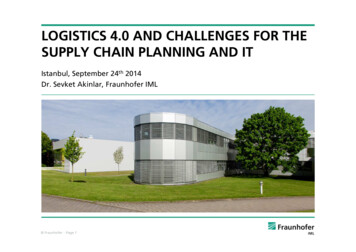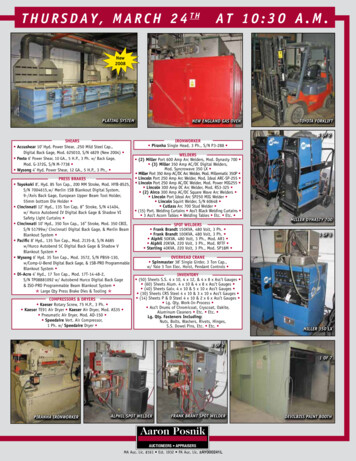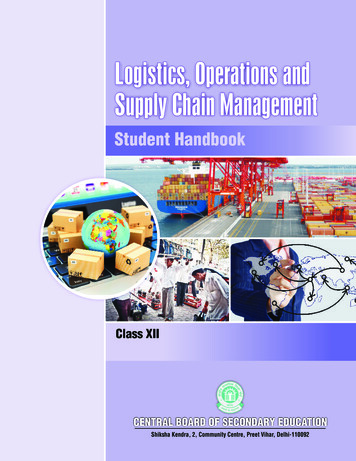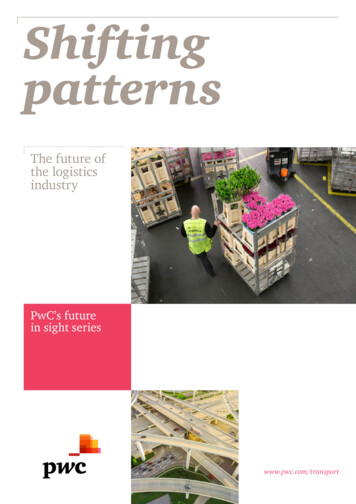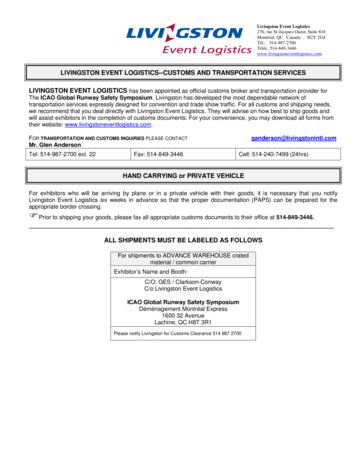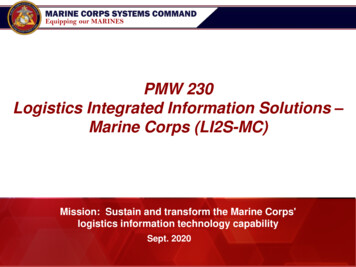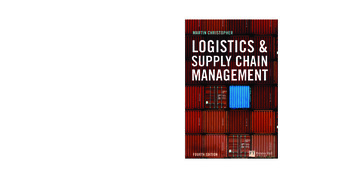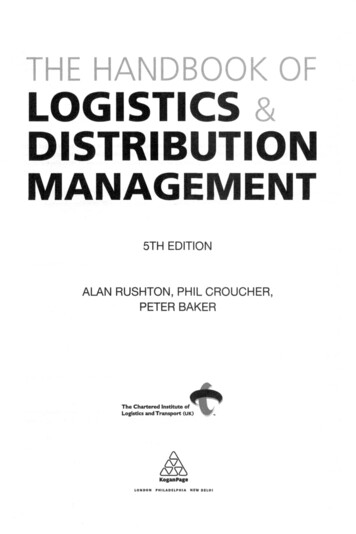
Transcription
THE HANDBOOK OFLOGISTICS &DISTRIBUTIONMANAGEMENT5TH EDITIONALAN RUSHTON, PHIL CROUCHER,PETER BAKERThe Chartered Institute ofLogistics and Transport (UK)52KoganPageLONDONPHILADELPHIANEW DELHI
CONTENTSList ofList of tablesPrefaceAbbreviationsfiguresviiixvxvixxiParti Concepts of logistics and distribution1Introduction to logistics and distributionIntroduction 3; Scope and definition 4; Historical perspective 7;Importance of logistics and distribution 9; Logistics and supply chainstructure 14; Summary 153Integrated logistics and the supply chainIntroduction 16; The total logistics concept 16; Planning for logistics 19;The financial impact of logistics 22; Globalization and integration 24;Integrated systems 25; Competitive advantage through logistics 27;Logistics and supply chain management 28; Summary 3016Customer service and logisticsIntroduction 32; The importance of customer service 32;The components of customer service 34; Two conceptual modelsof service quality 37; Developing a customer service policy 39;Levels of customer service 46; Measuring customer service 47;The customer service explosion 50; Summary 5132Channels of distributionIntroduction 52; Physical distribution channel types and structures 53;Channel selection 57; Outsourcing channels 61; Summary 6552Key issues and challenges for logistics and the supply chainIntroduction 66; The external environment 68; Manufacturingand supply 71; Logistics and distribution 74; Retailing 81;The consumer 83; Summary 8666
Part 2 Planning for logistics87Planning framework for logisticsIntroduction 89; Pressures for change 89; Strategic planning overview 91;Logistics design strategy 94; Product characteristics 96; The product lifecycle 99; Packaging 100; Unit loads 101; Summary 10189Logistics processesIntroduction 103; The importance of logistics processes 103;Logistics process types and categories 105; Approach 108;Tools and techniques 110; Summary 116103Supply chain segmentationIntroduction 117; Product segmentation 117; Demand and supplysegmentation 119; Marketing segmentation 121; Combined segmentationframeworks 122; Implementation 123; Summary 124117Logistics network planningIntroduction 125; The role of distribution centres and warehouses 126;Cost relationships 128; A planned approach or methodology 136; Initial analysisand option definition 138; Logistics modelling: logistics option analysis 143;Evaluate results: matching logistics strategy to business strategy 147;Practical considerations for site search 148; Summary 150125Logistics management and organizationIntroduction 151; Relationships with other corporate functions 151; Logisticsorganizational structures 153; Organizational integration 155;The role of the logistics or distribution manager 158; Payment schemes 160;The selection of temporary staff and assets 164; Summary 167151Multichannel fulfilmentIntroduction 168; Issues 169; Food retailing 170; Non-food retailing 172;Summary 175168Manufacturing logistics176Introduction 176; Typology of operations 177; Just-in-time 180;Manufacturing resource planning (MRPII) 183; Material requirements planning(MRP) 183; The MRP system 184; Flexible fulfilment (postponement) 187;The effects of distribution activities 188; Future developments 189; Summary 190Part 3 Procurement and inventory decisions191Basic inventory planning and managementIntroduction 193; The need to hold stocks 194; Types of stockholding/inventory 195; Stockholding policy implications for other logistics functions 197;Inventory costs 199; Reasons for rising inventory costs 200; Inventoryreplenishment systems 201; The reorder point and safety stock 203;The bullwhip effect 205; The economic order quantity 206;Demand forecasting 210; Summary 216193
ContentsvInventory and the supply chainIntroduction 217; Problems with traditional approaches to inventory planning 217;Different inventory requirements and the 'decoupling point' 218;The lead-time gap 220; Inventory and time 221; Analysing time and inventory 223;Inventory planning for manufacturing 224; Inventory planning for retailing 227;Summary 233217Procurement and supplyIntroduction 234; The procurement cycle 235; The scope of procurement 236;Setting the procurement objectives 236; Managing the suppliers 243;Expediting 246; Procurement performance measures 247; Collaborativeplanning, forecasting and replenishment 247; Factory gate pricing 248;E-procurement 248; Corruption 250; Summary 251234Part 4 Warehousing and storage253Principles of warehousingIntroduction 255; The role of warehouses 256; Strategic issues affectingwarehousing 258; Warehouse operations 259; Costs 263; Packaging andunit loads 263; Summary 265255Storage and handling systems (palletized)Introduction 266; Pallet movement 266; Pallet stacking 268; Palletizedstorage 272; Palletized storage - comparison of systems 286; Summary 288266Storage and handling systems (non-palletized)Introduction 290; Small item storage systems 291; Truck attachments 295;Long loads 296; Cranes 299; Conveyors 299; Automated guided vehicles 300;Hanging garment systems 301; Summary 302290Order picking and packingIntroduction 303; Order picking concepts 303; Order picking equipment 305;Sortation 313; Picking area layout 315; Slotting 316; Pick routes 316;Information in order picking 317; E-fulfilment 320; Picking productivity 320;Replenishment 321; Packing 322; Summary 324303Receiving and dispatchIntroduction 325; Receiving processes 325; Dispatch processes 326;Cross-docking 327; Returned goods 329; Receiving and dispatchequipment 329; Layouts 332; Summary 335325Warehouse designIntroduction 336; Design procedure 336; Summary 352336Warehouse management and informationIntroduction 353; Operational management 353; Performance monitoring 355;Information technology 358; Data capture and transmission 360;Radio data communication 362; Truck management 363; Summary 363353
viContentsPart 5 Freight transport36523International logistics: modal choiceIntroduction 367; Relative importance of the main modes of freighttransport 368; Method of selection 370; Operational factors 371;Transport mode characteristics 375; Consignment factors 379; Cost andservice requirements 380; Aspects of international trade 381; Summary 38736724Maritime transportIntroduction 389; Structure of the industry 389; Common shipping terms 391;Surcharges 393; Documentation 395; Vessel classification 396; Common shiptypes and their cargoes 398; Ports and cargo handling 401; Other factors 402;Summary 40438925Air transportIntroduction 405; Structure of the industry 405; Air cargo handling 407;Types of air freighter 409; Documentation 410; Air hubs and spokes 411;Air freight pricing 411; Air cargo security 414; Summary 41640526Rail and intermodal transportIntroduction 417; Intermodal equipment 418; Intermodal vehicles 426;Intermodal infrastructure 428; Mode shift grant schemes 429;Rail transport 429; Summary 43241727Road freight transport: vehicle selectionIntroduction 433; Main vehicle types 434; Types of operation 435;Load types and characteristics 443; Main types of vehicle body 446;The wider implications of vehicle selection 452; Vehicle acquisition 453;Summary 45543328Road freight transport: vehicle costingIntroduction 456; Reasons for road freight transport vehicle costing 456;Key aspects of road transport costing 458; Vehicle standing costs 460;Vehicle running costs 464; Overhead costs 466; Costing the total transportoperation 467; Whole life costing 468; Vehicle cost comparisons 471;Zero-based budgets 472; Summary 47345629Road freight transport: planning and resourcingIntroduction 474; Need for planning 475; Fleet management 476;Main types of road freight transport 478; Transport resources: requirementsand optimization 480; Vehicle routeing and scheduling issues 482; Manualmethods of vehicle routeing and scheduling 488; Computer routeing andscheduling 495; Other road-freight transport information systemsapplications 500; Summary 501474
Contents viiPart 6 Operational management50330Cost and performance monitoringIntroduction 505; Why monitor? 506; Different approaches to cost andperformance monitoring 508; What to measure against? 513; A logisticsoperational planning and control system 516; Good practice 517;Influencing factors 521; Detailed metrics and KPIs 522; The presentationof metrics 525; Summary 52750531BenchmarkingIntroduction 529; Why should an organization engage in benchmarking? 530;How to conduct a benchmarking exercise 530; Formal benchmarkingsystems 536; Benchmarking distribution operations 538; Summary 54752932Information and communication technology in the supply chainIntroduction 548; Basic communication 548; Supply chain planning 551;Warehousing 553; Inventory 553; Transport 554; Other applications 556;Trading using the internet - e-commerce 557; Summary 55954833Outsourcing: services and decision criteriaIntroduction 560; Outsourcing operations 560; Different service types 571;Value added services 577; Drivers and drawbacks of outsourcing 580;What are the critical factors of choice? 586; Summary 58856034Outsourcing: the selection processIntroduction 589; Approach 589; Detailed steps 591; Summary 61058935Outsourcing managementIntroduction 611; The need for management 612; Managing therelationship 612; Implementation planning 616; Monitoring an outsourcedlogistics operation 618; Summary 62261136Security and safety in distributionIntroduction 624; International security measures 625; Strategic securitymeasures 626; Tactical security measures 627; Safety in the distribution centreand warehouse 634; Summary 63762437Logistics and the environmentIntroduction 638; The European Union and environmental legislation 639;Logistics and environmental best practice 644; Alternative fuels 654;Summary 65863838Humanitarian logistics659Introduction 659; Key differences 660; Performance measurement 663;Key terms 665; Pre-positioning of resources 666; Assessment and planning 667;The cluster approach 668; Distribution 669; Summary 670; Further reading 671References 672Index675
36 Security and safety in distribution 624 Introduction 624; International security measures 625; Strategic security measures 626; Tactical security measures 627; Safety in the distribution centre and warehouse 634; Summary 637 37 Logistics and the environment 638 Introduction 638; The European Union and environmental legislation 639;
